Related Research Articles

A cartoon is a type of illustration, sometimes animated, typically in a non-realistic or semi-realistic style. The specific meaning has evolved over time, but the modern usage usually refers to either: an image or series of images intended for satire, caricature, or humor; or a motion picture that relies on a sequence of illustrations for its animation. Someone who creates cartoons in the first sense is called a cartoonist, and in the second sense they are usually called an animator.
Webcomics are comics published on a website or mobile app. While many are published exclusively on the web, others are also published in magazines, newspapers, or comic books.
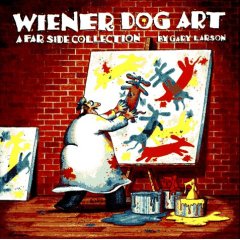
The Far Side is a single-panel comic created by Gary Larson and syndicated by Chronicle Features and then Universal Press Syndicate, which ran from December 31, 1979, to January 1, 1995. Its surrealistic humor is often based on uncomfortable social situations, improbable events, an anthropomorphic view of the world, logical fallacies, impending bizarre disasters, references to proverbs, or the search for meaning in life. Larson's frequent use of animals and nature in the comic is popularly attributed to his background in biology. The Far Side was ultimately carried by more than 1,900 daily newspapers, translated into 17 languages, and collected into calendars, greeting cards, and 23 compilation books, and reruns are still carried in many newspapers. After a 25-year hiatus, in July 2020 Larson began drawing new Far Side strips offered through the comic's official website.
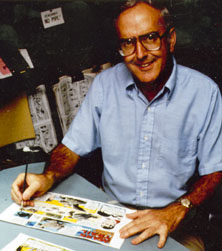
A cartoonist, also known as a comic strip creator, comic book artist, graphic novel artist, or comic book illustrator, is a visual artist who specializes in drawing cartoons or comics. Cartoonists include artists who handle all aspects of the work and those who contribute only part of the production. Cartoonists may work in a variety of formats, including booklets, comic strips, comic books, editorial cartoons, graphic novels, manuals, gag cartoons, illustrations, storyboards, posters, shirts, books, advertisements, greeting cards, magazines, newspapers, and video game packaging.
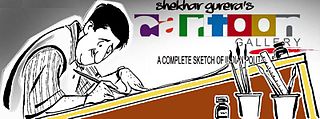
An editorial cartoonist, also known as a political cartoonist, is an artist who draws editorial cartoons that contain some level of political or social commentary. Their cartoons are used to convey and question an aspect of daily news or current affairs in a national or international context. Political cartoonists generally adopt a caricaturist style of drawing, to capture the likeness of a politician or subject. They may also employ humor or satire to ridicule an individual or group, emphasize their point of view or comment on a particular event.

Mutt and Jeff is a long-running and widely popular American newspaper comic strip created by cartoonist Bud Fisher in 1907 about "two mismatched tinhorns". It is commonly regarded as the first daily comic strip. The concept of a newspaper strip featuring recurring characters in multiple panels on a six-day-a-week schedule had previously been pioneered through the short-lived A. Piker Clerk by Clare Briggs, but it was Mutt and Jeff as the first successful daily comic strip that staked out the direction of the future trend.

Milton Arthur Paul "Milt" Caniff was an American cartoonist famous for the Terry and the Pirates and Steve Canyon comic strips.

Brenda Starr, Reporter is a comic strip about a glamorous, adventurous reporter. It was created in 1940 by Dale Messick for the Chicago Tribune Syndicate.

King Features Syndicate, Inc., is a print syndication company owned by Hearst Communications that distributes about 150 comic strips, newspaper columns, editorial cartoons, puzzles, and games to nearly 5,000 newspapers worldwide. King Features Syndicate is a unit of Hearst Holdings, Inc., which combines the Hearst Corporation's cable-network partnerships, television programming and distribution activities, and syndication companies. King Features' affiliate syndicates are North America Syndicate and Cowles Syndicate. Each week, Reed Brennan Media Associates, a unit of Hearst, edits and distributes more than 200 features for King Features.
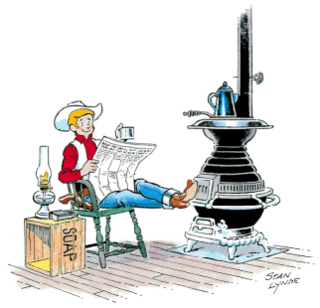
Rick O'Shay is a Western comic strip created by Stan Lynde, which debuted as a Sunday strip on April 27, 1958. The daily comic strip began on May 19 of the same year. It was distributed worldwide through the Chicago Tribune Syndicate. The final Rick O'Shay comic strips written and drawn by Lynde were the daily for 7 May 1977 and the Sunday for July 17, 1977. He left the syndicate after a disagreement. As the syndicate owned the rights to the strip, the popular Rick O'Shay comic strip was continued by others: Marian Dern (writer), Alfredo Alcala and Mel Keefer (artists). Publication ended on March 8, 1981.
Bruno was a webcomic written and drawn by Christopher Baldwin from 1 January 1996 to 14 February 2007, after initially appearing in print in The Massachusetts Daily Collegian starting January 27, 1994. Its plot concerns the life of an introspective young woman, set in the real world. Her unusual name comes from the Italian philosopher Giordano Bruno. In 1998 Peter Zale and Baldwin created the "first Internet comics crossover" between their respective webcomics Helen, Sweetheart of the Internet and Bruno.
Brian Crane is an American cartoonist who created Pickles, a comic strip featuring a retired couple, Earl and Opal Pickles, their family, and their family pets, Muffin (cat) and Roscoe (dog).
John Joseph Gallagher (1926–2005) was an American cartoonist and illustrator. He contributed to most major magazines in the 1950s and 1960s, signing his work “Gallagher.” He won the National Cartoonist Society Gag Cartoon Award in 1957 and 1971.
Glenn McCoy is a conservative American cartoonist, whose work includes the comic strip The Duplex and the daily panel he does with his brother Gary entitled The Flying McCoys. McCoy previously produced editorial cartoons until May 2018, when he refocused his career on animations after being discharged from his job of 22 years at the Belleville News-Democrat. All three cartoon features are syndicated by Andrews McMeel Syndication.
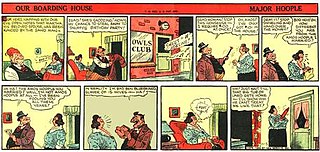
Our Boarding House is an American single-panel cartoon and comic strip created by Gene Ahern on October 3, 1921 and syndicated by Newspaper Enterprise Association. Set in a boarding house run by the sensible Mrs. Hoople, it drew humor from the interactions of her grandiose, tall-tale-telling husband, the self-styled Major Hoople, with the rooming-house denizens and his various friends and cronies.

Tribune Content Agency (TCA) is a syndication company owned by Tribune Publishing. TCA had previously been known as the Chicago Tribune Syndicate, the Chicago Tribune New York News Syndicate (CTNYNS), Tribune Company Syndicate, and Tribune Media Services. TCA is headquartered in Chicago, and had offices in various American cities, the United Kingdom, the Netherlands, and Hong Kong.
A comic strip syndicate functions as an agent for cartoonists and comic strip creators, placing the cartoons and strips in as many newspapers as possible on behalf of the artist. A syndicate can annually receive thousands of submissions, from which only two or three might be selected for representation. In some cases, the work will be owned by the syndicate as opposed to the creator. The Guinness World Record for the world's most syndicated strip belongs to Jim Davis' Garfield, which at that point (2002) appeared in 2,570 newspapers, with 263 million readers worldwide.
Uclick LLC was an American corporation selling "digital entertainment content" for the desktop, the web and mobile phones. Uclick operated several consumer websites, including the comic strip and editorial cartoon site GoComics and the puzzle and casual game sites ThePuzzleSociety.com and UclickGames.com.
Barbara Brandon-Croft is an American cartoonist, best known for creating the comic strip Where I'm Coming From, and for being the first nationally syndicated African-American female cartoonist.
Notable events of the late 1990s in webcomics.
References
- 1 2 3 Menefee, Craig (March 19, 1998). "Comic Strips Crossover On The Net". New Straits Times .
It lasted two weeks... thousands of views a day
- ↑ Stripper's Guide
- ↑ Helen, Sweetheart of the Internet (website) (archived)
- ↑ Archived October 17, 2014, at the Wayback Machine Peter Zale